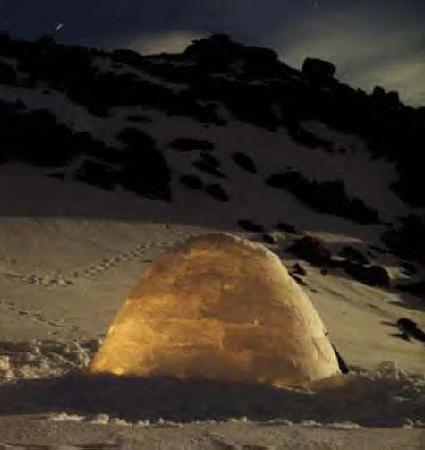|
|
Canku Ota |
|
|
(Many Paths) |
||
|
An Online Newsletter Celebrating Native America |
||
|
January 26, 2002 - Issue 54 |
||
|
|
||
|
Children Learn Winter Survival Skills at Nature Center |
||
|
by Zaz Hollander Anchorage
Daily News-January 14, 2002
|
||
|
credits:
|
 Naturalist
Carol Lloyd grabbed the attention of more than 30 local kids gathered
for an afternoon lesson in winter survival Saturday at the Eagle River
Nature Center. Naturalist
Carol Lloyd grabbed the attention of more than 30 local kids gathered
for an afternoon lesson in winter survival Saturday at the Eagle River
Nature Center.
"Has anybody ever watched Survivor'?" A bunch of mitten-covered hands went up. "Have you watched them rub two sticks together to make a fire? It usually takes them a couple days to get their fire started," Lloyd said. "You need to start with tinder." The group split up, rummaging through the birch and spruce trees below the center to find grass, birch bark and tiny branches to use as fire starter. Eight-year-old Ryan Turpin ran up with a new kind of tinder: a small, round, brown snowshoe hare scat. "Let's give it a try," Turpin said, his big gray hat nearly falling over his eyes. Maybe that particular critter needed more roughage. The fire didn't take. But the lessons started the youths on a path that may save their lives. Conditions in Alaska change so fast that anyone who spends time outside must be prepared for survival, Michelle Spain said Friday in an interview. The Willow resident joins her husband, Mike, in search-and-rescue expeditions coordinated with Alaska State Troopers. Spain, an avid snowmachiner, "takes everything but the kitchen sink" when she goes out. Her winter essentials are fire starter, light, hand warmers, bunny boots, global positioning satellite system, extra food and plenty of water. Spain recalled a couple who got stuck snowmachining at Hatcher Pass in whiteout conditions with two small children. The father left his wife and kids and walked to a friend's house, she said. He called the troopers. The troopers called Mike Spain. Spain found the family shivering beneath a tree. "The kids' hands were just about frozen. Their feet were wet and frozen. It was awful," Michelle Spain said. Preventing that kind of near-disaster was the point of the activities at the nature center. Before going outside, the kids got a quick course on building snow caves. Conditions didn't provide enough snow for hands-on training. Lloyd told the youths how to build four kinds of snow shelters, starting with a body-length trench lined with some kind of vapor barrier like a trash bag or branches. Another option is shoveling snow high into the air and letting it fall in a head-high pile. You can dig a cave, she said, but only once the snow settles. This kind of shelter is best with snow formed at different temperatures so it sticks together. A snow cave demands enough snow to hollow out a space 3 or 4 feet wide. Dig out a dome-shaped space so snow melted by your breath drips down the side of the cave, Lloyd said. With the crusty snow Anchorage has now, an igloo made from blocks cut out of the snow may be the best way to go, she said. The shelters don't have to be pretty. They just have to work. "All we're trying to do is live till the next day," Lloyd said. To learn more about winter and winter survival, check out our Favorites in this issue! |
|
|
||
|
|
||
| Canku Ota is a free Newsletter celebrating Native America, its traditions and accomplishments . We do not provide subscriber or visitor names to anyone. Some articles presented in Canku Ota may contain copyright material. We have received appropriate permissions for republishing any articles. Material appearing here is distributed without profit or monetary gain to those who have expressed an interest. This is in accordance with Title 17 U.S.C. section 107. | ||
|
Canku Ota is a copyright © 2000, 2001, 2002 of Vicki Lockard and Paul Barry. |
||
|
|
|
|
|
The "Canku Ota - A Newsletter Celebrating Native America" web site and its design is the |
||
|
Copyright © 1999, 2000, 2001, 2002 of Paul C. Barry. |
||
|
All Rights Reserved. |
||
